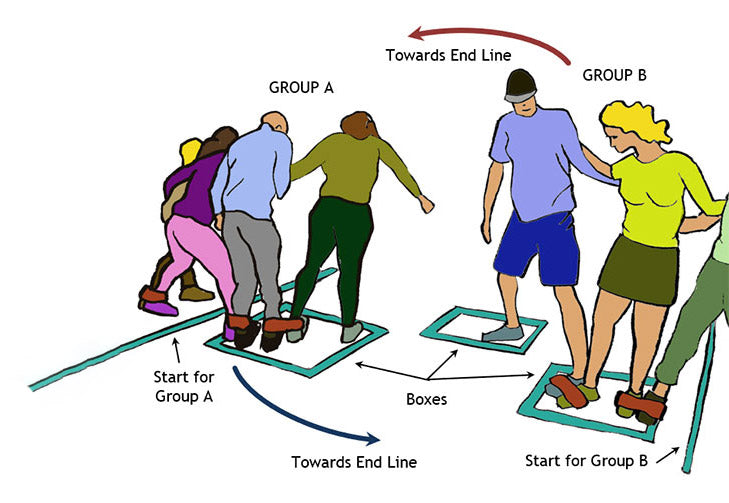Purpose
This is a team building exercise where delegates need to solve a problem while deprived of a particular sense. The purpose is to see how the group self-organises, communicates, understands what needs to be done to achieve the goal and executes their plan efficiently. This exercise is ideal for large groups.
Objective
Line up based on a numerical order while being unable to see or talk to others.
What You Need
- A large empty area where people can easily walk around without bumping into objects.
- Blank cards. You need one set for each group. Before the exercise you should prepare the cards by writing a sequence of numbers on them:
- There should be no repetitions.
- Use one or two-digit numbers.
- Leave gaps in the sequence. For example, don’t use 1, 2, 3, 4, ..., 9. Instead, use 3, 6, 7, 10, 12, 16, 17, 19.
- Timer
- One blindfold for each delegate
- Prizes
Setup
- Divide the delegates to two groups. Ideally, each group should consist of about 8 people or more to make the exercise interesting. Hence, this exercise is ideal if you have a large group of people. You can also consider dividing delegates into more than two groups.
- Use one set of cards for each group. Approach each person in isolation, show a card number at random, let them memorise it and continue until each member of the group is assigned a number. It is important that no one else learns about their numbers while you go through this.
- Move to the other group and repeat the same process to assign a new set of numbers.
Stage 1: No Talking
- Now explain that no one can talk. The objective for each group is to form a line with an ordered sequence of numbers. This is a competition between the two groups so their activity is timed.
- Expect groups to plan and organise their activity, nominate a leader and find a way of communicating other than talking. Examples of communication are finding a pen and paper, using mobile phones, computers or using hand gestures.
- Allocate enough time for both groups to finish the task. Make sure the other group continues if one group finished as you want to know how long each group takes to complete the task.
Stage 2: No Sight
- Assign numbers again to each individual in each group in the same way you did before. Now each person has a new number.
- Explain that this time they will be blindfolded but they can talk to each other. The objective is the same as before; to form an ordered line. They should not talk yet.
- Distribute blindfolds to everyone and get them to place it on their eyes. Make sure everyone is happy with this and that no one can see.
- Through the entire exercise make sure that delegates remain safe.
- On your mark, let them start the exercise.
- This time, they can easily share their numbers with each other by talking, but they need to help each other move into a line as they cannot see. Observe how they communicate and approach the task as a group.
- As before, measure the time taken by each group to complete the task and make a note of it.
Stage 3: No Talking and No Sight
- Now that they have gone through the two exercises, they should be familiar with the process. They should also become more comfortable working with each other as a team.
- Explain that in this final stage, they will be doing the same exercise but this time they be blindfolded and they cannot talk. They will need to find a way of communicating and getting into an ordered line.
- As before, assign new numbers and then distribute blindfolds.
- Start the exercise and observe the groups for their teamwork.
- Make note of how long they took to complete the task.
- Bring back everyone together.
- Reveal the timing for all three stages of this exercise. The team who won two or more stages wins. Give prizes to the winning team.
- Follow with a discussion and provide feedback based on your observation of their performance.
Timing
Explaining the Exercise: 5 minutes
Activity: 3 * 10 min for each stage = 30 minutes
Group Feedback: 10 minutes
Discussion
What did you think of your approach to the task in stage one, two or three? How did you coordinate your activities? What options did you consider for communication when you could not talk? Was the method you used effective? What did you think of the other group’s approach? Did you become better at the task in stage 2 or 3? Which stage did you find most challenging? What did you think of your team’s performance as a whole?
Soft Skills Training Materials
Get downloadable training materials
Online Train the Trainer Course:
Core Skills
Learn How to Become the Best Trainer in Your Field
All Tags
Training Resources for You

Course Design Strategy
Available as paperback and ebook

Free Training Resources
Download a free comprehensive training package including training guidelines, soft skills training activities, assessment forms and useful training resources that you can use to enhance your courses.

Our Comprehensive Guide to Body Language

Train the Trainer Resources
Get Insights - Read Guides and Books - Attend Courses
Training Materials
Get downloadable training materials on: Management Training, Personal Development, Interpersonal Development, Human Resources, and Sales & Marketing














Leave a comment
All comments are moderated before being published.
This site is protected by hCaptcha and the hCaptcha Privacy Policy and Terms of Service apply.